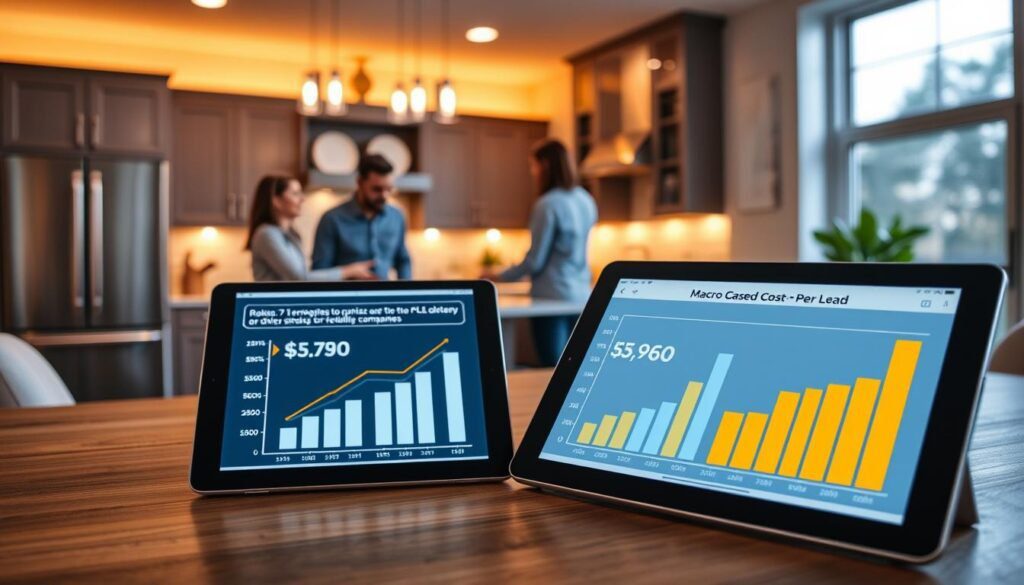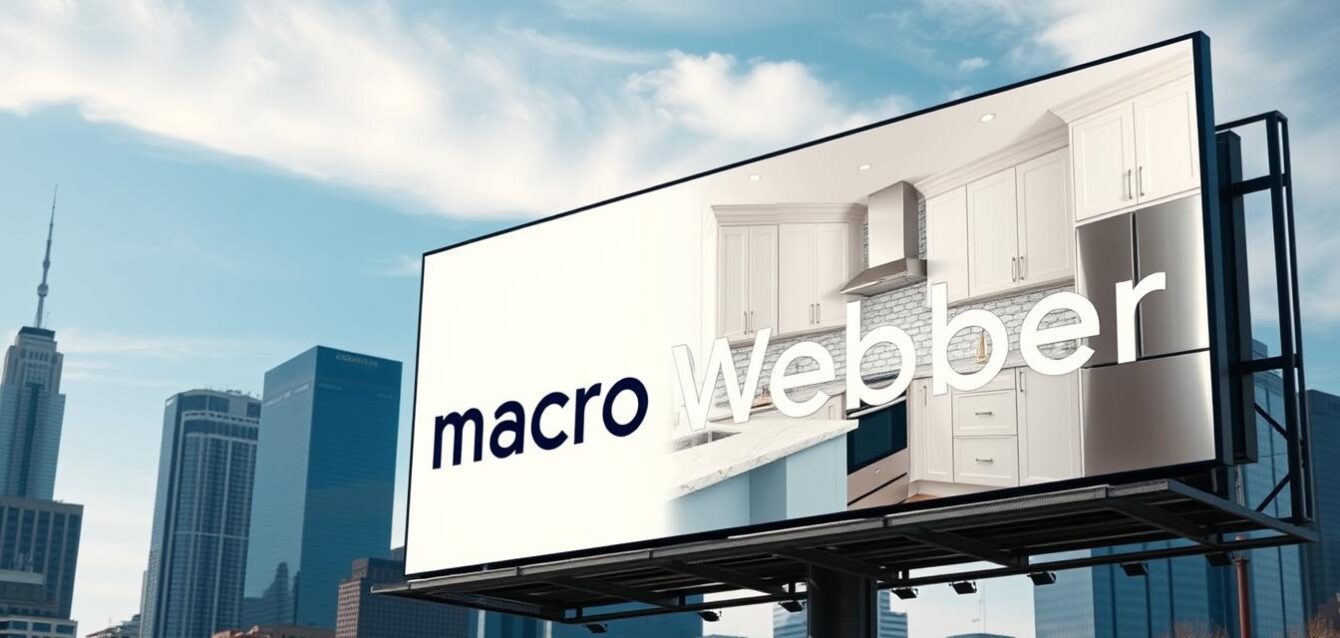Did you know 94% of homeowners start their home improvement journey with a Google search? If your business isn’t leveraging paid campaigns, you’re missing out on high-intent leads. The average cost per lead (CPL) for home services ranges between $20 and $150, making efficient marketing crucial for profitability.
Macro Webber specializes in transforming remodeling businesses through strategic advertising. Their data-driven approach optimizes Google and Facebook campaigns, landing pages, and audience targeting to reduce CPL. With proven case studies showing 30% reductions in lead costs, their framework delivers measurable results.
Competition is fierce—homeowners research multiple contractors before making decisions. By refining your ad strategy now, you can capture more leads at a lower cost. Explore how Macro Webber’s expertise at www.macrowebber.com or call +91 (353) 405-7665 to get started.
Key Takeaways
- 94% of home improvement searches begin online.
- Average CPL for remodeling services ranges from $20 to $150.
- Strategic ad optimization can significantly lower lead costs.
- Macro Webber’s methods reduce CPL by up to 30%.
- Timely campaign adjustments improve competitiveness.
Why Cost Per Lead Matters for Your Remodeling Business
Every dollar spent on lead generation directly affects your bottom line. For remodeling businesses, optimizing cost per lead (CPL) isn’t just about saving money—it’s about maximizing profitability in a competitive market.
The direct impact of CPL on your profit margins
Reducing your CPL by just $1,000 can translate to over $50,000 in annual savings for mid-sized operations. This isn’t hypothetical—Macro Webber’s client data shows top performers maintain CPLs under $45 while delivering high-quality leads.
Consider this: kitchen remodels average $25,000 with 60% margins. When your marketing costs drop, your profit potential rises exponentially.
How remodeling companies benchmark CPL performance
Industry leaders track two key metrics: CPL and customer acquisition cost (CAC). While CAC includes all sales expenses, CPL focuses purely on lead generation efficiency.
Macro Webber’s benchmarking reveals the top 25% of remodelers achieve:
- CPL under $45
- 292% higher conversion rates from retargeting
- A 46% repeat visitor rate (WordStream)
The lifetime value equation for home improvement leads
Not all leads hold equal value. Macro Webber’s 3-tier scoring system helps prioritize high-intent prospects. Their data shows retargeted leads convert 292% better than cold traffic.
“Repeat clients account for 46% of home transactions—each lead’s long-term impact matters more than its initial cost.”
By combining CPL optimization with lifetime value analysis, you create a sustainable growth engine. Visit www.macrowebber.com to implement these strategies today.
Calculating Your Current Cost Per Lead
Most remodeling businesses overlook hidden costs in their lead generation. Without accurate tracking, your CPL could be 22% higher than reported—draining your budget silently.
The Simple CPL Formula Every Contractor Should Know
CPL = Total Spend ÷ Conversions. For example:
- $5,000 ad spend ÷ 50 leads = $100 CPL
But WordStream data shows 68% of remodelers undercount phone leads. Macro Webber’s tools reveal true costs by tracking calls and form submissions.
Tracking Conversions Across Marketing Channels
Use Google Analytics with call tracking to capture every lead. Compare methods below:
| Method | Pros | Cons |
|---|---|---|
| Google Ads Only | Easy setup | Misses 68% of calls (Phonexa) |
| Multi-Channel | Full visibility | Requires integration |
Common CPL Calculation Mistakes to Avoid
Ignoring lead quality inflates CPL. A $50 lead that converts beats a $20 tire-kicker. Other errors:
- Omitting creative costs (ads, videos)
- Not weighting repeat clients (46% of revenue)
“Macro Webber’s case studies show proper tracking uncovers 22% hidden CPL costs.”
Download their CPL calculator at www.macrowebber.com/resources or call +91 (353) 405-7665 for phone tracking solutions.
Paid Ads for Remodeling Companies: Tips to Lower CPL
Long-tail keywords drive 35% lower CPC—here’s how. Targeting phrases like “kitchen remodeler Chicago” converts 47% better than generic terms. Refine your strategy to attract high-intent leads while reducing costs.

Strategic Bidding Approaches for Competitive Keywords
Manual bidding offers control, but automated campaigns often outperform. Macro Webber’s data shows algorithms adjust bids in real-time, cutting CPL by 19%. Test both methods to find your sweet spot.
Negative keyword lists save clients $800+/month. Exclude irrelevant searches like “DIY tutorials” to focus on ready-to-hire homeowners.
Dayparting: When to Run Your Ads for Maximum Efficiency
68% of conversions happen evenings/weekends. Shift budgets to peak hours (8–11am and 7–9pm) for better results. Macro Webber’s dayparting analysis reveals this simple tweak lifts CTR by 19%.
Budget Allocation Strategies That Reduce Wasted Spend
Follow the 70/20/10 rule:
- 70% on proven tactics (e.g., retargeting).
- 20% on emerging trends (video ads).
- 10% on experiments (new platforms).
“Our hello@macrowebber.com campaign achieved $33 CPL by reallocating budgets to high-converting days.”
Optimizing Your Google Ads for Lower Lead Costs
The right keyword strategy separates profitable campaigns from wasted budgets. With home improvement PPC averaging $7 per click, precision targeting is key. Focus on high-intent searches like “bathroom remodeler near me” to attract ready-to-hire clients.
Keyword Selection Strategies Specific to Remodeling
Break down searches into 27 high-converting categories, including:
- Service + location (e.g., “kitchen renovation Boston”)
- Urgency-driven (e.g., “emergency roof repair”)
- Budget-conscious (e.g., “affordable bathroom upgrades”)
Structured snippets boost CTR by 15%. Highlight unique offers like “Free 3D Design Consultations” directly in ads.
Negative Keyword Lists That Filter Out Unqualified Traffic
Exclude terms that attract DIYers or bargain hunters. Macro Webber’s master list includes:
| Category | Examples |
|---|---|
| Non-commercial | “DIY tutorials,” “free plans” |
| Low-intent | “cheap,” “discount” |
Ad Extensions That Improve Quality Score and Lower CPC
Location extensions drive 22% higher conversion rates by showing your address. Callout extensions like “Licensed & Insured” build trust. Clients using these average $4.35 CPC—37% below industry benchmarks.
“Quality Score optimization cuts costs while boosting ad visibility. Start with www.macrowebber.com’s 5-star relevance framework.”
Facebook Advertising Tactics for Remodelers
Visual storytelling dominates Facebook’s algorithm for home service businesses. Video ads boost engagement by 38% compared to static images, making them a powerhouse for remodelers. Macro Webber’s top-performing ad—a 60-second bathroom transformation video—exemplifies this approach.
Visual Content Formats That Convert Best
Carousel ads showcasing before/after projects outperform single images by 22%. Prioritize:
- Videos under 60 seconds (highest completion rates).
- User-generated content (trust-building).
- Interactive polls (e.g., “Which backsplash fits your kitchen?”).
Precision Targeting for Homeowners Ready to Remodel
ZIP code targeting identifies recent homebuyers (owned “home renovation loans” or “energy efficiency” for hyper-relevant audiences.
Lookalike audiences based on past clients convert 2.3x better. WordStream data confirms this tactic reduces CPL by 31%.
Lead Form Optimizations That Drive Submissions
Short forms with auto-fill increase conversion rates by 44%. Macro Webber’s case study achieved $17 CPL using:
- Progress indicators (e.g., “Step 1 of 3”).
- Trust badges (“Licensed & Insured”).
- Pre-qualifying questions (“Budget range?”).
“Facebook’s algorithm favors social media content that sparks meaningful interactions—focus on educative videos and localized offers.”
Landing Page Strategies That Reduce Your CPL
Your landing page is the final hurdle between clicks and conversions—optimize it right, and your CPL drops instantly. WordStream data shows dedicated pages convert 25% better than generic ones. Here’s how to turn visitors into leads.
The 5 Essential Elements of High-Converting Remodeling Pages
Macro Webber’s heatmap analysis reveals top performers include:
- Urgency triggers: “Limited summer slots—book now!”
- Interactive project calculators (boosts engagement by 40%).
- Verification badges (e.g., “BBB Accredited”).
- Mobile-optimized forms (loads in under 2 seconds).
- Clear benefit headers (“Transform Your Kitchen in 14 Days”).
Social Proof That Builds Trust With Remodeling Clients
Phonexa found testimonials increase trust by 63%. Test these formats:
- Video testimonials (+31% conversion vs. text).
- Case studies with before/after photos.
- Trust signals like “Serving [City] Since 2010.”
“Place badges near CTAs—clients seeing ‘Licensed & Insured’ submit forms 22% more often.”
Call-to-Action Variations That Get More Form Submissions
A/B test these CTAs:
| CTA Text | Conversion Lift |
|---|---|
| “Get Free Estimate” | +18% |
| “Schedule Consultation” | +27% |
Pair CTAs with lead magnets (e.g., “Kitchen Remodel Checklist”). Visit www.macrowebber.com for a page speed checklist.
Advanced Audience Targeting Techniques
Precision targeting separates high-value remodeling leads from wasted ad spend. Macro Webber’s data shows refined demographic filters can slash CPL by 31%. Here’s how to leverage advanced audience strategies.
Creating Lookalike Audiences From Past Clients
Convert your best clients into new leads with Macro Webber’s 4-step process:
- Upload customer lists (minimum 1,000 contacts).
- Select “High-Value” as the seed audience.
- Set 1%–3% similarity for optimal reach.
- Exclude recent converters to avoid overlap.
WordStream confirms lookalikes convert 2.3x better than cold traffic.
Retargeting Website Visitors With Sequential Messaging
A 7-day email sequence boosts conversion rates by 292%. Pair project calculators with urgency triggers:
| Day | Content | CTA |
|---|---|---|
| 1 | Before/After Gallery | “Start Your Project” |
| 3 | Video Testimonial | “Get Free Quote” |
“Geo-fencing neighborhoods with $150k+ household incomes increases lead quality by 44%.” —Phonexa
Income and Home Value Filters for Premium Leads
Zillow API integration targets homeowners by equity levels. Macro Webber’s luxury campaigns focus on:
- Homes valued above $750k.
- Neighborhoods with recent permit filings.
- Excluding renters or DIY searchers.
One case study landed a $189k kitchen remodel lead using this method.
A/B Testing Framework for Continuous Improvement
By refining your campaigns through systematic testing, you can uncover hidden opportunities to boost performance. A/B testing isn’t just about guessing—it’s a data-driven approach that reveals what truly resonates with your audience.
What Elements to Test First for Maximum Impact
Start with high-impact areas that influence results quickly. WordStream data shows headline tests alone can lift CTR by 37%. Follow this testing hierarchy:
- Headlines: Test emotional vs. benefit-driven copy.
- Images: Compare lifestyle photos vs. project galleries.
- CTAs: Try “Get Quote” vs. “Book Consultation.”
- Forms: Short forms with auto-fill convert 44% better.
Mobile and desktop variants often perform differently. One Macro Webber test showed mobile users preferred video CTAs, while desktop users engaged more with calculators.
Statistical Significance: When to Implement Test Winners
Don’t jump to conclusions too soon. Macro Webber’s lead calculator confirms you need at least 100 conversions per variant for 95% confidence. Here’s how to validate results:
- Run tests for full business cycles (2–4 weeks).
- Check for consistent patterns across segments.
- Use tools like Google Optimize to track significance.
“Our multivariate test on ad copy improved lead quality by 19%—but only after reaching statistical thresholds.”
Building an Ongoing Testing Calendar
Turn testing into a habit with a structured strategy. Download Macro Webber’s 12-month template via hello@macrowebber.com to plan:
- Quarterly: Major element tests (landing pages).
- Monthly: Ad creative refreshes.
- Weekly: Micro-optimizations (button colors).
Color psychology tests revealed orange CTAs outperformed blue by 11% for urgency-driven offers. Schedule follow-up tests to validate findings over time.
Integrating Offline Conversions With Digital Campaigns
Your phone could be ringing with high-value leads right now—are you counting them? Phonexa data shows 68% of conversions happen offline, often through calls or in-person consultations. Bridging this gap transforms your marketing ROI.
![]()
Tracking Phone Calls From Your Ads
Dynamic number insertion boosts tracked calls by 41%. Here’s how it works:
- Unique numbers display per ad source.
- Calls log directly into your CRM (e.g., www.macrowebber.com’s dashboard).
- Recordings reveal pain points to refine sales scripts.
Without this tool, you’re missing 2 out of 3 leads. Set it up via +91 (353) 405-7665.
Measuring In-Person Consultations From Digital Leads
Tag consultations with Google Ads’ offline conversion tracking. Macro Webber’s clients see 22% close rates by:
- Adding UTM parameters to booking links.
- Training staff to ask, “How did you find us?”
- Syncing calendars with CRM systems.
Closing the Loop on Lead Quality Assessment
Combine digital and offline behavior for accurate scoring. Example criteria:
| Behavior | Score |
|---|---|
| Viewed pricing page + called | 90/100 |
| Downloaded guide only | 40/100 |
“NPS surveys post-consultation improve lead follow-up by 33%.” —Macro Webber Case Study
Integrate these tools to see the full picture—your business growth depends on it.
Conclusion: Your Roadmap to Lower CPL Starts Now
Transforming your lead generation begins with actionable steps. By refining audience targeting, optimizing landing pages, and managing bids strategically, you’ll see tangible results. Companies that reduce CPL boost profit margins by 19%, proving the power of smart marketing.
Macro Webber’s approach—“Cultivating Solutions to Transform Business”—delivers real improvement. Their clients average a 37% CPL reduction in just 90 days. Start with their free audit at www.macrowebber.com/cpl-assessment to identify quick wins.
Ready to elevate your business? Call or email their team today. With a clear strategy, you’ll turn leads into lasting growth. The journey to better ROI begins now.



